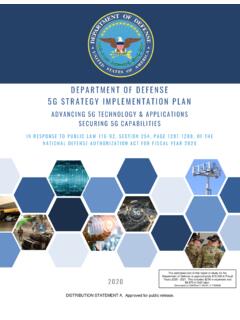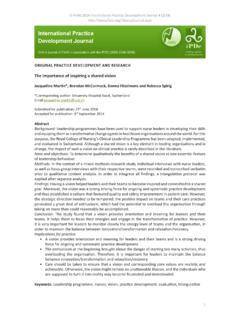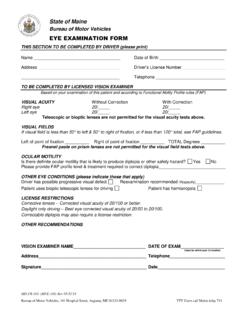Transcription of USD(R&E) Strategic Vision and Critical Technology Areas
1 RESEARCH AND ENGINEERING UNDER SECRETARY OF DEFENSE 3030 DEFENSE PENTAGON WASHINGTON, DC 20301-3030 February 1, 2022 SUBJECT: USD(R&E) Technology Vision for an Era of Competition The Office of the Under Secretary of Defense for Research and Engineering (OUSD(R&E) will spearhead a National Defense Science and Technology strategy for the Department of Defense (DoD), informed by the 2022 National Defense Strategy (NDS) and structured around three Strategic pillars: mission focus, foundation building, and succeeding through teamwork. This Technology strategy will chart a course for the United States' military to strengthen its technological superiority amidst a global race for technological advantage.)
2 To maintain the United States military' s technological advantage, the Department will champion research, science, Technology , engineering, and innovation. From the earliest days of this country the role of Technology in shaping military concepts and providing for the defense of the nation has been essential. The demands of the present era call for new operational concepts, increasingly joint operations, and quickly fielding emerging science and Technology opportunities. Strategic competitors to the United States have greater access to commercial state-of-the-art technologies than ever before and can wield these technologies to be disruptive to America's interests and its national security.
3 The challenges facing our country are both diverse and complex, ranging from sophisticated cyber-attacks to supply chain risks, and from defending against hypersonic missiles to responding to biological threats. In an ever shifting and fast-moving global environment, technological advantage is not stagnant and the Department cannot rely on today's Technology to ensure military technological dominance tomorrow. It is imperative for the Department to nurture early research and discover new scientific breakthroughs to prevent technological surprise. The Department must harness the incredible innovation ecosystem both domestically and globally in order to stay ahead of our competitors.
4 A. Innovation in an era of competition The Department of Defense's Research and Engineering community welcomes cooperation and competition. As Secretary of Defense Austin said in his December 2021 speech at the Reagan National Defense Forum, "America isn't a country that fears competition. And we're going to meet this one with confidence and resolve." Competition has helped to bring about the United States' private sector and Technology industry, both of which are the most vibrant in the world. Competition helped advance the space program, the seeds of modem information Technology , and a myriad of derivative technologies that every day drive our national security and economic activity.
5 1 While the United States thrives on competition, we also excel at cooperation. The challenges facing warfighters will be solved through cooperation between the Government; the Defense Industrial Base; academia; Federally Funded Research and Development Centers (FFRDCs); University Affiliated Research Centers (UARCs); small businesses, new entrants, and startups; our international partners; and even with our competitors. Successful competition requires imagining our military capability as an ever-evolving collective, not a static inventory of weapons in development or sustainment. In many cases, effective competition benefits from sidestepping symmetric arms races and instead comes from the creative application of new concepts with emerging science and Technology .
6 This era of Strategic competition demands collective cooperation. Effective competition requires agility-in initiating new Technology development, rapid experimentation in relevant mission environments, and rapid transition to the users. B. Technology Strategy Pillars Driven by clarity of mission, built upon strong foundations, and enabled by teamwork, the Department' s Technology strategy will enable the Department to innovate at speed and scale now and into the future. This Technology strategy will be anchored by three pillars: Mission Focus: Leverage the United States' incredible Technology innovation potential to solve the Department's tough operational, engineering, and mission-focused challenges.
7 Mission Focus requires a focus on warfighting outcomes with constant communication and iteration between research and development teams and mission owners, and solutions that cut across multiple weapon systems, Military Services, and Defense organizations. The OUSD(R&E) will balance pursuing mission-aligned Technology with the need to conduct research and development in emerging sciences that can provide leap-ahead capabilities. The Department' s Technology strategy will be informed by emerging threats and empower the Department to achieve its mission objectives as laid out in the NDS.
8 The OUSD(R&E) will work closely with the Military Services and Combatant Commands on the development and implementation of the Department's Technology strategy. Foundation Building: Set the foundation to attract and build a strong, talented future technical workforce that works in modernized laboratories and test facilities. In this dynamic competitive environment, it is essential to invest in our people and infrastructure. The Department must modernize its system engineering and software engineering practices to promote continuous prototyping and experimentation. The OUSD(R&E) will break down barriers to success through policies that encourage innovation and risk taking.
9 2 Succeed through Teamwork: Maximize our asymmetric advantages by partnering with the larger innovation ecosystem, from industry to universities and to laboratories, allies and partners. The Department must expand its relationships with the entire Technology ecosystem across America and its allies and partners. Innovation has always been a strength of the United States, and the Department will harness that innovation. The Department must focus its developmental resources on unique capabilities needed by the military and quickly adopt the best commercial dual-use technologies. In the era ahead, the Department will diversify partnerships to bring in creative new entrants.
10 Allies and partner nations are an asymmetrical advantage for the United States, and the Department will partner with nations that are aligned with the principles of the United States to jointly develop and deploy Technology . C. Critical Technology Areas The OUSD(R&E) works closely with the Military Services, Combatant Commands, industry, academia, and other stakeholders to ensure that the Department' s science and Technology strategy addresses the key national security challenges-from rising seas to a rising China-that the United States faces today and will face in the future. Three categories of Technology Areas recognize the more varied and complex environment for investment, development, and application of Technology that characterizes the early 21st century.






